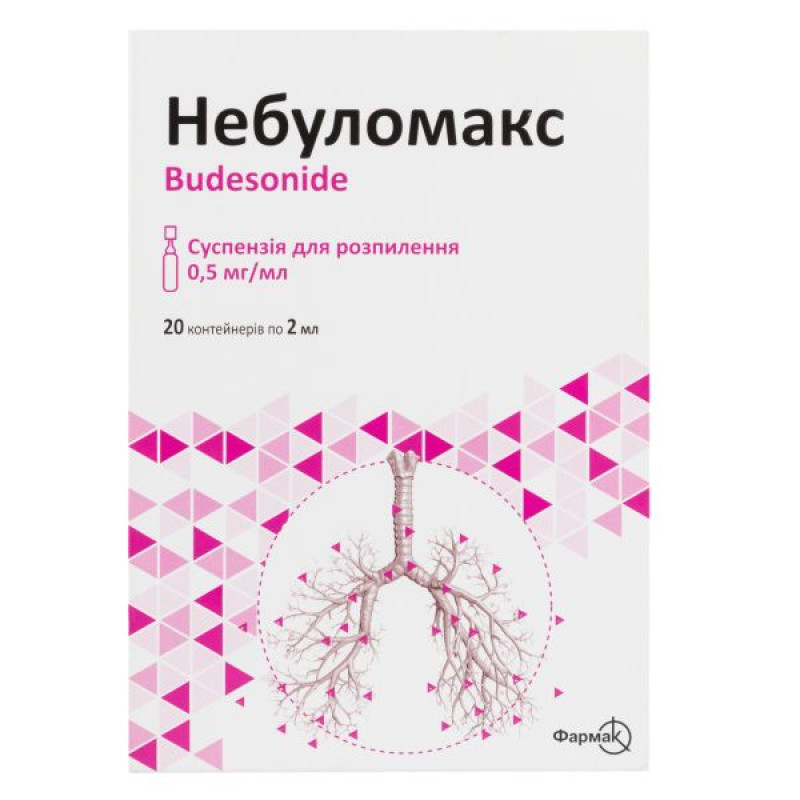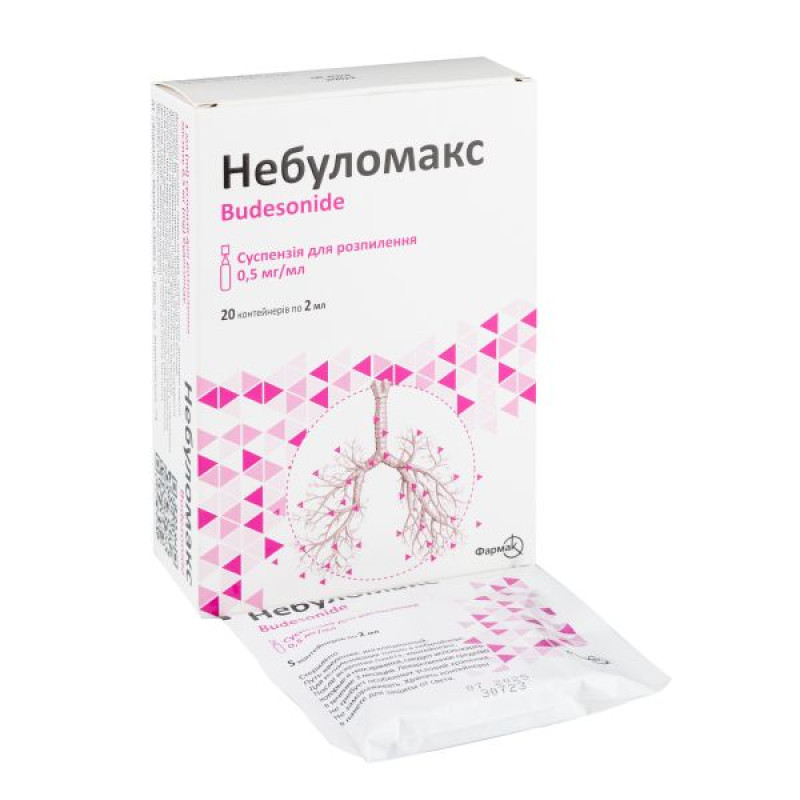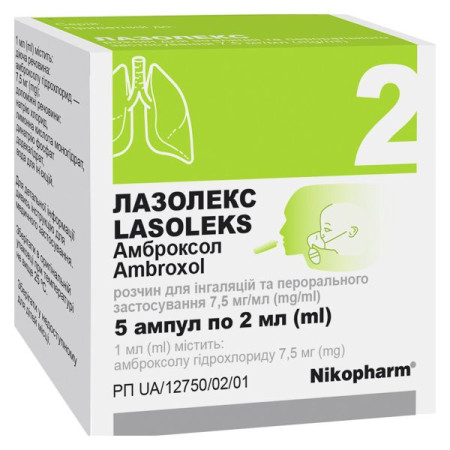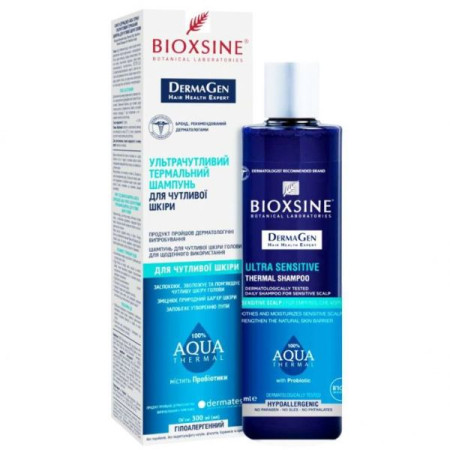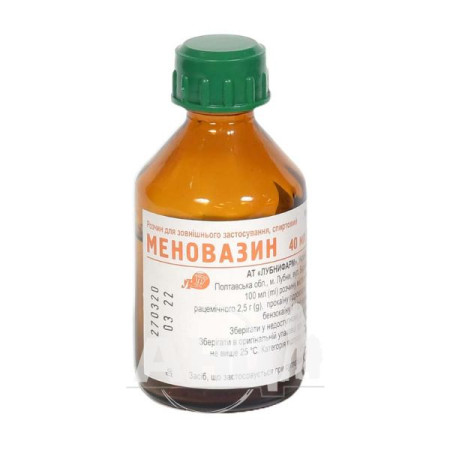Nebulomax suspension for inhalation 0.5 mg/ml nebules 2 ml No. 20
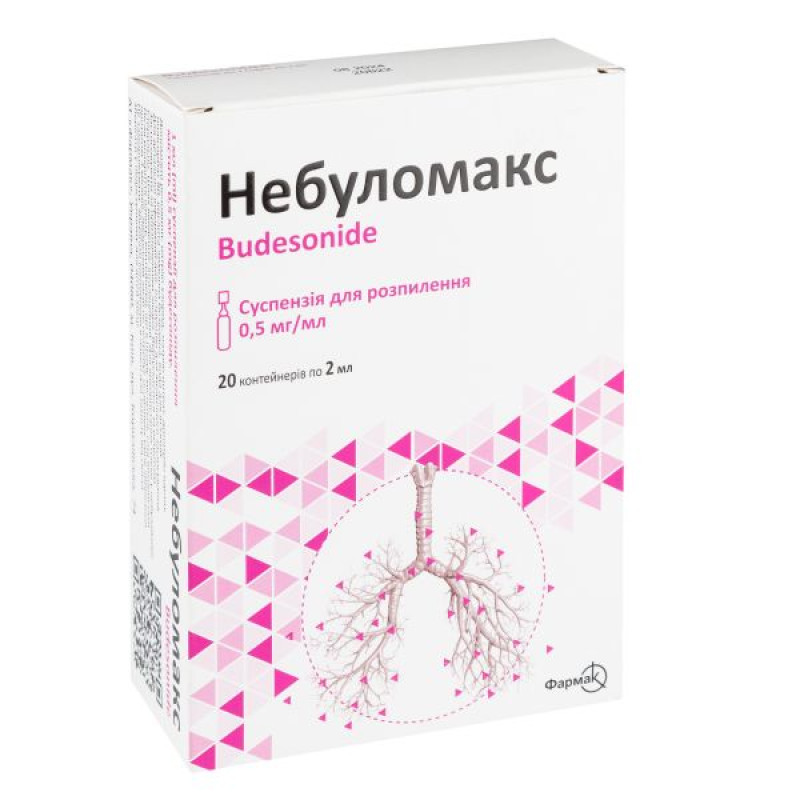
Instructions Nebulomax suspension for inhalation 0.5 mg/ml nebules 2 ml No. 20
Composition
active ingredient: budesonide;
1 ml of suspension for nebulization contains 0.125 mg or 0.25 mg or 0.5 mg of budesonide;
Excipients: sodium chloride, sodium citrate, disodium edetate, polysorbate 80, anhydrous citric acid, water for injections.
Dosage form
Suspension for spraying.
Main physicochemical properties: white or almost white suspension, easily resuspended, filled into polyethylene containers containing a single dose.
Pharmacotherapeutic group
Inhalants used for the treatment of obstructive airway diseases. Glucocorticoids. ATX code R03B A02.
Pharmacological properties
Pharmacodynamics.
Budesonide is a glucocorticosteroid with a strong local anti-inflammatory effect.
Local anti-inflammatory effect
The exact mechanism of action of glucocorticosteroids in the treatment of bronchial asthma is not fully understood. Anti-inflammatory effects, such as inhibition of the release of inflammatory mediators and suppression of cytokine-mediated immune responses, are likely to play an important role. The potency of budesonide, measured as affinity for the glucocorticosteroid receptor, is approximately 15 times greater than that of prednisolone.
A clinical trial in asthmatic patients comparing inhaled and oral budesonide formulations at doses designed to achieve similar systemic bioavailability showed a statistically significant superiority of inhaled budesonide over oral budesonide compared to placebo. Thus, the therapeutic effect of standard doses of inhaled budesonide can be largely explained by direct action on the airways.
Clinical effect
Budesonide has an anti-inflammatory effect, which is manifested in the reduction of bronchial obstruction in both the early and late stages of an allergic reaction.
Airway reactivity
It has also been shown that in patients with hyperresponsiveness, budesonide reduces airway reactivity to histamine and methacholine.
Studies have shown that the earlier budesonide treatment is started after the onset of bronchial asthma symptoms, the sooner improvement in lung function can be expected.
Effect on plasma cortisol concentration
In studies with healthy volunteers, budesonide inhalation powder has been shown to have a dose-dependent effect on plasma and urinary cortisol levels. Budesonide inhalation powder, when used at recommended doses, has significantly less effect on adrenal function than prednisone 10 mg, as confirmed by ACTH assays.
Clinical application – bronchial asthma
The efficacy of budesonide has been studied in a large number of studies that have demonstrated its efficacy in adults and children when used once or twice daily for the prophylactic treatment of persistent asthma. Some representative examples of these studies are provided below.
Children. Effect on growth
In short-term studies, a small and usually transient reduction in growth rate was observed, usually occurring within the first year of treatment. Limited data from long-term studies suggest that most children and adolescents treated with inhaled budesonide eventually reached their adult height. However, in one study, children treated with high-dose inhaled budesonide by dry powder inhaler (400 mcg daily) for 6 years without titration to the lowest effective dose were on average 1.2 cm shorter in adulthood than those treated with placebo for the same period. For titration to the lowest effective dose and monitoring of growth in children, see section 4.4.
Exercise-induced bronchial asthma
Inhaled therapy with budesonide has been effectively used to prevent exercise-induced asthma attacks.
Clinical application – croup
Several studies have compared budesonide with placebo in children with croup. Representative examples of studies investigating the use of budesonide in children with croup are given below.
Effectiveness of use in children with mild to moderate croup
To determine whether budesonide improves croup symptom scores and reduces the length of hospital stay, a randomized, double-blind, placebo-controlled trial was conducted in 87 children (aged 7 months to 9 years) hospitalized with a clinical diagnosis of croup. Participants received an initial dose of budesonide nebulized suspension (2 mg) or placebo, followed by a dose of budesonide nebulized suspension (1 mg) or placebo every 12 hours. Budesonide nebulized suspension significantly improved croup severity scores at 12 and 24 hours, and at 2 hours in patients with an initial croup symptom score of greater than 3. The length of hospital stay was also reduced by 33%.
A randomized, double-blind, placebo-controlled trial was conducted to compare the efficacy of budesonide and placebo in 83 infants and children (aged 6 months to 8 years) hospitalized with a clinical diagnosis of croup. Patients received either budesonide 2 mg or placebo every 12 hours for up to 36 hours or until discharge. The total croup symptom score was determined before drug administration and at 0, 2, 6, 12, 24, 36, and 48 hours after the initial dose. At 2 hours, the budesonide and placebo groups showed similar improvements in croup symptom scores, with no statistically significant difference between the groups. At 6 hours, the croup symptom score in the budesonide group was statistically significantly better than in the placebo group, and this improvement compared to placebo was equally evident at 12 and 24 hours.
Pharmacokinetics.
Absorption
The systemic availability of budesonide in adults after administration of the suspension for nebulization via a jet nebulizer is approximately 15% of the nominal dose and 40-70% of the dose administered to the patient. A small part of this amount is due to absorption of the drug that has been swallowed. Maximum plasma concentrations are reached approximately 10-30 minutes after the start of nebulization and are approximately 4 nmol/l after a dose of 2 mg.
Distribution
The volume of distribution of budesonide is approximately 3 l/kg. Binding to plasma proteins is on average 85–90%.
Metabolism
Budesonide undergoes extensive (≈90%) first-pass metabolism through the liver to metabolites with low glucocorticosteroid activity. The glucocorticosteroid activity of the main metabolites, 6β-hydroxybudesonide and 16α-hydroxyprednisolone, is less than 1% of that of budesonide. The metabolism of budesonide occurs predominantly with the participation of CYP3A, a member of the cytochrome P450 subfamily.
Breeding
Budesonide metabolites are excreted mainly by the kidneys in unchanged or conjugated form. Unchanged budesonide is not detected in the urine. In healthy adults, the systemic clearance of budesonide is usually high (approximately 1.2 l/min), and the terminal half-life of budesonide after intravenous administration is on average 2–3 hours.
Linearity
The kinetics of budesonide are dose-proportional when used in clinically relevant doses.
In a study in which patients were also given 100 mg ketoconazole twice daily, an average 7.8-fold increase in plasma budesonide levels was observed after oral administration (single dose of 10 mg). There is no information on interactions of this type with inhaled budesonide, but a significant increase in plasma levels is expected.
Pharmacokinetics in specific patient groups
Children
In children aged 4–6 years with bronchial asthma, the systemic clearance of budesonide is approximately 0.5 l/min. The clearance in children (per 1 kg of body weight) is approximately 50% higher than in adults. In children with bronchial asthma, the terminal half-life of budesonide after inhalation is approximately 2.3 hours. Approximately the same figure is observed in healthy adults. In children aged 4–6 years with bronchial asthma, the systemic availability of budesonide after administration of a suspension for nebulization through a jet nebulizer (Pari LC Jet Plus with Pari Master compressor) is approximately 6% of the nominal dose and 26% of the dose delivered to the patient. The systemic availability in children is approximately half that in healthy adults.
In children aged 4–6 years with bronchial asthma, the maximum plasma concentration is reached within 20 minutes after the start of the nebulization and is approximately 2.4 nmol/l after a dose of 1 mg. Budesonide exposure (Cmax and AUC) after a single dose of 1 mg by nebulization in children aged 4–6 years are comparable to those in healthy adults who received the same dose of budesonide through the same nebulization system.
Patients with liver damage
The effects of budesonide may be increased in patients with liver disease.
Plasma clearance after intravenous administration of budesonide was similar in patients with liver cirrhosis and in healthy volunteers. After oral administration, systemic bioavailability of budesonide increased due to impaired liver function due to reduced first-pass metabolism. The clinical significance of these changes for budesonide treatment is not fully understood, as data on inhaled budesonide are lacking, but an increase in plasma levels and, consequently, an increased risk of systemic adverse reactions can be expected.
Patients with kidney damage
The pharmacokinetics of budesonide in patients with renal insufficiency are unknown.
Indication
Nebulomax contains a potent non-halogenated corticosteroid, budesonide, intended for the treatment of bronchial asthma in patients for whom the use of inhalers with compressed air atomization of medicinal substances or in the form of a dry powder dosage form is ineffective or inappropriate.
Nebulomax is also recommended for use in infants and children with croup (a complication of acute viral upper respiratory tract infection, also known as laryngotracheobronchitis or subligamentous laryngitis), which is an indication for hospitalization.
Contraindication
Hypersensitivity to the active substance or to any of the excipients of the drug Nebulomax.
Interaction with other medicinal products and other types of interactions
Budesonide is mainly metabolised by CYP3A4. Concomitant use with CYP3A inhibitors, such as itraconazole, ketoconazole, and HIV protease inhibitors, is expected to increase the risk of systemic side effects of budesonide several-fold (see section 4.4). Since no data are available on the posology, it is recommended that these medicinal products be avoided. If this is not possible, the interval between administration of these medicinal products should be as long as possible and a reduction in the dose of budesonide should be considered.
Limited data on a similar interaction with high doses of inhaled budesonide demonstrate that with concomitant use of itraconazole at a dose of 200 mg once daily, administration of inhaled budesonide (single dose of 1000 mcg) leads to a significant increase in the concentration of the substance in the blood plasma (on average 4-fold).
In women who were simultaneously taking estrogens or hormonal contraceptives, the concentration of budesonide in the blood plasma increased and the effect of corticosteroids was enhanced, however, when budesonide was used together with low doses of combined oral contraceptives, this effect was absent.
Concomitant use of Nebulomax with CYP3A inhibitors, including cobicistat, is expected to increase the risk of systemic adverse reactions. This combination should be avoided unless the benefit outweighs the increased risk of systemic corticosteroid side effects. In such cases, patients should be monitored for systemic corticosteroid side effects.
Because adrenal function may be suppressed, the ACTH stimulation test, intended to diagnose pituitary insufficiency, may give false results (low values).
Application features
Nebulomax is not intended for the rapid relief of acute episodes of bronchial asthma that require the use of short-acting inhaled bronchodilators.
If a patient is not responding to short-acting bronchodilators or if they require more inhalations than usual, medical intervention is necessary. In such a situation, consideration should be given to increasing the usual therapy, for example by increasing the dose of inhaled budesonide or adding a long-acting beta-agonist or prescribing a course of oral glucocorticosteroids.
Respiratory tract infections
The drug should be used with caution in patients with active or inactive pulmonary tuberculosis and fungal or viral infections of the respiratory tract.
Patients with steroid dependence.
Particular caution should be exercised when switching from oral glucocorticosteroids to inhaled corticosteroids, as there is a risk of transient adrenal insufficiency during this period.
Patients who have required emergency high-dose corticosteroid therapy or long-term treatment with inhaled corticosteroids at the highest recommended dose are also at risk of developing adrenal insufficiency. Such patients may develop signs and symptoms of adrenal insufficiency during periods of severe stress. Additional systemic corticosteroid therapy may be considered in stressful situations or during elective surgery.
When switching from oral steroid therapy to Nebulomax, in most cases there is a decrease in systemic corticosteroid action, which may lead to the appearance of allergy or arthritic symptoms such as rhinitis, eczema and muscle and joint pain. Specific treatment should be initiated for these conditions. Usually, insufficient effect of glucocorticosteroid therapy can be suspected if symptoms such as fatigue, headache, nausea, vomiting occur, although this is rare. In such cases, a temporary increase in the dose of oral glucocorticosteroids may sometimes be necessary.
Systemic effects may occur with any inhaled glucocorticosteroid, especially when used at high doses for long periods of time. The likelihood of such effects is much lower with inhaled corticosteroids than with oral corticosteroids. Possible systemic effects include Cushing's syndrome, Cushingoid features, adrenal suppression, growth retardation in children and adolescents, decreased bone mineral density, cataracts and glaucoma, and, less commonly, a number of mental and behavioral disorders, including psychomotor hyperactivity, sleep disturbances, anxiety, depression or aggression (especially in children). It is therefore important to titrate the dose of inhaled corticosteroid to the lowest dose at which effective control of bronchial asthma is maintained.
As with other inhaled therapies, paradoxical bronchospasm, accompanied by increased wheezing immediately after inhalation, may occur. If this occurs, treatment with inhaled budesonide should be discontinued immediately and the patient assessed and, if necessary, alternative therapy initiated.
Liver dysfunction
Decreased hepatic function may affect the elimination of glucocorticosteroids from the body, as the rate of elimination is reduced and systemic exposure is increased. The patient should be warned about the possible development of side effects.
Concomitant use of other medicines
Concomitant use with CYP3A inhibitors, such as itraconazole, ketoconazole, HIV protease inhibitors and cobicistat-containing products is expected to increase the risk of systemic corticosteroid side effects. This combination should be avoided unless the benefit outweighs the increased risk; if the combination cannot be avoided, patients should be monitored for systemic corticosteroid-related side effects. This is of limited clinical significance during short-term (1-2 weeks) treatment with itraconazole or ketoconazole or other potent CYP3A inhibitors, but should be considered during long-term treatment. A reduction in the budesonide dose should also be considered (see section 4.5).
The nebulizer chamber should be cleaned after each use. The nebulizer chamber and the mouthpiece or breathing mask should be washed with hot water and a mild detergent. The nebulizer chamber should be thoroughly rinsed and dried by connecting it to the compressor or air intake.
Oral candidiasis
Oral candidiasis may develop during treatment with inhaled corticosteroids. This infection may necessitate the use of appropriate antifungal agents and in some patients may necessitate discontinuation of inhaled corticosteroid treatment (see also section 4.2).
Pneumonia in patients with COPD
An increased incidence of pneumonia, including pneumonia requiring hospitalization, has been observed in patients with COPD receiving inhaled corticosteroids.
There is evidence of an increased risk of pneumonia with increasing corticosteroid dose, but this has not been conclusively demonstrated in any of the studies.
For inhaled corticosteroid drugs, there is no comprehensive clinical evidence of intraclass differences in the magnitude of the risk of developing pneumonia.
Physicians should remain vigilant for the possible development of pneumonia in patients with COPD, as the clinical features of such infections are similar to those of COPD exacerbations.
Risk factors for developing pneumonia in patients with COPD include smoking, older age, low body mass index (BMI), and severe COPD.
Vision impairment
Visual disturbances may occur with systemic and topical corticosteroids. If a patient presents with symptoms such as blurred vision or other visual disturbances, an ophthalmologist should be consulted to evaluate possible causes, including cataracts, glaucoma, or rare diseases such as central serous chorioretinopathy (CSR), which have been reported following systemic or topical corticosteroid use.
Children
Effect on growth
In children receiving long-term treatment with inhaled corticosteroids, regular monitoring of growth is recommended. If growth is slowed, therapy should be reviewed with the aim of reducing the dose of inhaled corticosteroid to the lowest possible dose at which effective control of bronchial asthma is maintained. The benefits of corticosteroid therapy should be carefully weighed against the possible risk of growth retardation. In addition, it is important to refer the patient for consultation with a pediatric pulmonologist.
Use during pregnancy or breastfeeding
Pregnancy
Most results of prospective epidemiological studies and experience of international use of budesonide in the post-marketing period indicate that treatment with inhaled budesonide during pregnancy did not lead to undesirable effects on the health of the fetus/newborn child.
It is important for both the fetus and the pregnant woman to maintain adequate asthma treatment during pregnancy. As with other drugs used during pregnancy, the benefits of budesonide for the pregnant woman should be weighed against the risks to the fetus. Inhaled glucocorticosteroids should be preferred over oral glucocorticosteroids because of their lower systemic effects when used in doses required to achieve the same respiratory response.
Animal studies have also shown that prenatal excessive exposure to glucocorticoids may be associated with an increased risk of intrauterine growth retardation, development of cardiovascular disease in adulthood, and permanent alterations in glucocorticoid receptor density, neurotransmitter metabolism, and behavior at doses that are below teratogenic.
During pregnancy, inhaled budesonide should be used at the lowest effective dose, taking into account the risk of exacerbation of bronchial asthma.
Breast-feeding
Budesonide passes into breast milk. However, when using therapeutic doses of Nebulomax, no effects on the breast-fed child are expected. Nebulomax can be used during breastfeeding.
Ability to influence reaction speed when driving vehicles or other mechanisms
Nebulomax does not affect the ability to drive vehicles and operate other mechanisms.
Method of administration and doses
Dosage
The dosage of Nebulomax should be adjusted depending on the individual needs of the patient.
The dose administered to the patient depends on the nebulization equipment used. The nebulization time and the dose delivered depend on the flow rate, the volume of the nebulizer chamber and the fill volume. The air flow rate through the nebulizer device used should be 6–8 liters per minute. The appropriate fill volume for most nebulizers is 2–4 ml. The dose should be reduced to the minimum necessary to maintain adequate control of bronchial asthma. The highest dose (2 mg per day) in children under 12 years of age should be prescribed only in case of severe asthma and for a limited period of time.
Bronchial asthma
Beginning of therapy
At the beginning of treatment, during periods of exacerbation of bronchial asthma and when reducing or discontinuing oral glucocorticosteroids, the recommended dose of Nebulomax is:
Adults (including the elderly): usually 1–2 mg 2 times a day. In very severe cases, the dose may be further increased.
Children over 12 years of age: dosage is the same as for adults.
Children aged 6 months to 12 years: 0.5–1 mg 2 times a day.
Supportive therapy
The maintenance dose should be selected individually and should be equal to the lowest dose at which the patient has no symptoms of the disease.
Adults (including elderly patients) and children over 12 years of age: 0.5–1 mg 2 times a day.
Children aged 6 months to 12 years: 0.25–0.5 mg 2 times a day.
Patients taking oral glucocorticoids as maintenance therapy
Nebulomax allows the patient to withdraw or significantly reduce the dose of oral corticosteroids while maintaining control of asthma. The patient should be relatively stable before the transition from oral steroids is initiated. A high dose of Nebulomax should be administered for approximately 10 days in combination with the previously used oral steroid. After this, the oral steroid dose should be gradually reduced to the lowest possible level, for example, 2.5 mg prednisolone or equivalent per month. Often, the oral steroid can be completely discontinued by replacing it with Nebulomax. For more information on withdrawal of oral corticosteroids, see the section "Special instructions for use".
Patients not taking oral glucocorticoids
The therapeutic effect is usually achieved within 10 days. Patients with excessive bronchial mucus secretion may initially be treated with a short-term (approximately 2 weeks) additional course of oral corticosteroids. After a course of oral medications, Nebulomax as monotherapy may be sufficient treatment.
Dosage features
Nebulomax can be mixed with 0.9% saline and with nebulizer solutions containing terbutaline, salbutamol, fenoterol, acetylcysteine, sodium cromoglicate or ipratropium bromide. The mixture should be used within 30 minutes.
Dosage recommendations
Table 1
| Dose (mg) | Volume of the drug Nebulomax, suspension for nebulization | ||
| 0.125 mg/ml | 0.25 mg/ml | 0.5 mg/ml | |
| 0.25 | 2 ml | 1 ml | - |
| 0.5 | - | 2 ml | 1 ml |
| 0.75 | - | 3 ml | - |
| 1.0 | - | 4 ml | 2 ml |
| 1.5 | - | 6 ml | 3 ml |
| 2.0 | - | 8 ml | 4 ml |
For patients for whom it is desirable to increase the therapeutic effect, especially patients without a large amount of mucus in the respiratory tract, it is recommended to increase the dose of the drug Nebulomax instead of combination treatment with oral corticosteroids, which is associated with a lower risk of systemic side effects.
Croup
For children with croup, the usual dose is 2 mg of nebulized budesonide. This dose may be given as a single dose or as two 1 mg doses 30 minutes apart. The dose may be repeated every 12 hours for a maximum of 36 hours or until clinical improvement.
Method of application
The container must be detached from the strip, gently shaken and opened by breaking off the tip tab. Carefully squeeze the contents of the container into the nebulizer chamber. Discard the empty container and cover the nebulizer chamber with the cap.
Nebulomax should be administered using a jet nebulizer with a nozzle or a suitable breathing mask. The nebulizer should be connected to an air compressor that provides sufficient air flow (6–8 l/min) and the fill volume should be 2–4 ml.
Note: It is important that the patient:
carefully read the instructions for use given in the patient information leaflet included in the packaging of each nebulizer;
understood that ultrasonic nebulizers are not suitable for administering the drug Nebulomax, and therefore their use is not recommended;
was informed about the possibility of mixing the drug Nebulomax with 0.9% saline and with nebulization solutions containing terbutaline, salbutamol, fenoterol, acetylcysteine, sodium cromoglycate and ipratropium bromide, and was also aware of the need to use the mixture within 30 minutes;
rinsed the mouth with water after inhaling the prescribed dose to minimize the risk of developing oropharyngeal candidiasis;
washed the face with water after using the breathing mask to prevent skin irritation;
properly rinsed and stored the nebulizer according to the manufacturer's instructions.
Children.
Nebulomax should be used in children according to indications (see sections “Indications” and “Method of administration and dosage”).
Overdose
Overdose of Nebulomax, even when used in excessive doses, will not pose a clinically significant problem. If Nebulomax is used for a long period in high doses, systemic glucocorticosteroid effects such as hypercortisolism and adrenal suppression may occur.
Side effects
The following definitions were used to estimate the frequency of adverse reactions. The frequency is defined as follows: very common (≥1/10); common (≥1/100 to <1/10); uncommon (≥1/1,000 to <1/100); rare (≥1/10,000 to <1/1,000); very rare (<1/10,000).
Adverse reactions classified by system organ class and frequency
Table 2
| Organ system classes | Frequency | Adverse reactions |
| Infections and infestations | Often | Oropharyngeal candidiasis Pneumonia (in patients with COPD) |
| On the part of the immune system | Rarely | Immediate and delayed hypersensitivity reactions*, including rash, contact dermatitis, urticaria, angioedema and anaphylactic reaction |
| From the endocrine system | Rarely | Signs and symptoms of systemic corticosteroid effects, including adrenal suppression and growth retardation** |
| Mental disorders | Infrequently | Anxiety |
| Depression | ||
| Rarely | Psychomotor hyperactivity | |
| Sleep disturbances | ||
| Aggression | ||
| Behavioral changes (mostly in children) | ||
| From the nervous system | Infrequently | Tremor*** |
| From the organs of vision | Infrequently | Cataract |
| Blurred vision (see section "Special warnings and precautions for use" | ||
| Unknown | Glaucoma | |
| Respiratory, thoracic and mediastinal disorders | Often | Cough |
| Hoarseness | ||
| Throat irritation | ||
| Rarely | Bronchospasm | |
| Dysphonia | ||
| Hoarseness**** | ||
| Skin and subcutaneous tissue disorders | Rarely | Bruises |
| Musculoskeletal and connective tissue disorders | Infrequently | Muscle spasms |
* See below for a description of specific adverse reactions; facial skin irritation.
** See the "Children" section below.
*** Based on frequency reported in clinical trials.
**** Rarely in children.
Signs or symptoms of systemic glucocorticosteroid side effects may occasionally occur with inhaled glucocorticosteroids, which is likely to depend on the dose, time of exposure, concomitant and previous exposure to corticosteroids, and individual sensitivity (see section "Special warnings and precautions for use").
Description of selected adverse reactions
Oropharyngeal candidiasis is a potential risk due to drug deposition. The patient should be instructed to rinse the mouth with water after each maintenance dose inhalation to minimize this risk.
As with any inhalation therapy, the development of paradoxical bronchospasm is very rare (see section "Special warnings and precautions for use").
Occasionally, when using a nebulizer with a breathing mask, a hypersensitivity reaction in the form of facial skin irritation has been reported. To prevent irritation, wash your face after using the mask.
In the pooled clinical trials, 13,119 patients received inhaled budesonide and 7,278 patients received placebo. The incidence of anxiety was 0.52% for inhaled budesonide and 0.63% for placebo; the incidence of depression was 0.67% for inhaled budesonide and 1.15% for placebo.
Children
Due to the risk of growth retardation in children, growth monitoring is necessary as described in the section "Special warnings and precautions for use".
Reporting of adverse reactions
It is important to report suspected adverse reactions during the post-marketing period of a medicinal product. This allows for continuous monitoring of the benefit/risk balance of the medicinal product. Healthcare professionals are required to report any suspected adverse reactions through the national reporting system.
Expiration date
2 years.
Once the package is opened, the containers contained therein should be used within 3 months.
Do not use the drug after the expiration date indicated on the package.
Storage conditions
The medicine does not require any special storage conditions.
Do not freeze. Keep containers in the bag to protect from light.
Keep out of reach of children.
Packaging
2 ml in a single-dose container. 5 containers in a package. 4 packages in a pack.
Vacation category
According to the recipe.
Producer
JSC "Farmak".
Location of the manufacturer and address of its place of business.
Ukraine, 04080, Kyiv, Kyrylivska St., 74.
There are no reviews for this product.
There are no reviews for this product, be the first to leave your review.
No questions about this product, be the first and ask your question.







